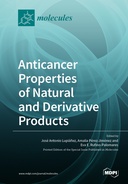Explore

Anticancer Properties of Natural and Derivative Products
0 Ungluers have
Faved this Work
Login to Fave
Natural products are bioactive compounds synthesized by terrestrial and marine plants, microorganisms and animals, whose main objective is to prevent them from attacks by predators and/or pathogens. Traditionally since ancient times, different cultures have used these compounds for the prevention and treatment of various human diseases. During the last few years, it has been reported that most of these phytochemicals possess a variety of interesting and significant biological properties, such as analgesic, antiallodynic, antidiabetic, antioxidant, antiparasitic, antimicrobial, antiviral, antiatherogenic, anti-inflammatory, antiproliferative, antitumor and normal growth stimulants, as well as significant cardioprotective and neuroprotective activity. This thematic book aims to collect and disseminate some of the most significant and recent contributions of the use of the natural compounds called phytochemicals, as well as some of their chemical derivatives, for the prevention and treatment of cancer and other accompanying diseases. On the other hand, in recent years, the synthesis of numerous chemical derivatives of these natural compounds has also intensified, with the aim of enhancing their bioactive capacities. Among all these bioactivities, special attention has been paid to its antitumor capacity through the potential modulation of cancer initiation and growth, cell differentiation, apoptosis and autophagy, angiogenesis, and metastatic dissemination. In addition, a considerable number of studies have linked their anticancer effects to their anti-inflammatory and antioxidant activities.
This book is included in DOAB.
Why read this book? Have your say.
You must be logged in to comment.
Rights Information
Are you the author or publisher of this work? If so, you can claim it as yours by registering as an Unglue.it rights holder.Downloads
This work has been downloaded 120 times via unglue.it ebook links.
- 120 - pdf (CC BY) at Unglue.it.
Keywords
- 1,3-dipolar cycloaddition
- 3-hydroxy-β-ionone
- actin cytoskeleton
- Adenosma bracteosum
- AKT/PI3K signaling pathway
- anti-cancer
- anti-inflammatory agent
- anti-proliferative activity
- anticancer activity
- anticancer agent
- antioxidant
- antioxidant activity
- antioxidant enzymes
- Apoptosis
- Autophagy
- betulin glycoconjugates
- betulinic acid
- bioactive compounds
- Breast cancer
- Cancer
- caspase-3
- Caveolin-1
- Cell Cycle
- cell line
- chemoprevention
- chemotherapy
- click chemistry
- Complementary Medicine
- Cytotoxicity
- danthron
- DNA
- DPPH
- Elaeagnus angustifolia
- emodin
- EMT
- extract
- GC-MS
- gingival fibroblasts
- glioblastoma (GBM)
- grapes
- hepatocellular carcinoma (HCC)
- human hepatocarcinoma HepG2 cells
- hypericin
- in vivo
- Interaction
- isolated compounds
- lactucopicrin (LCTP)
- lung metastases
- maslinic acid
- medicinal mushrooms
- Melanoma
- metabolites
- migration activity
- Moringa oleifera
- n/a
- natural compounds
- natural extract
- natural photosensitive compounds
- natural product
- NF-κB
- Olea europaea L.
- oleanolic acid
- oral cancer
- Oxidative Stress
- p62/SQSM1
- photodynamic therapy
- photosensitiser
- Pogostemon cablin (PPa extract)
- proliferation
- quinizarin
- Reference, information & interdisciplinary subjects
- Research & information: general
- rhodamine B
- ROS level
- ROS levels
- squamous cell carcinoma
- synergism
- temozolomide (TMZ)
- thema EDItEUR::G Reference, Information and Interdisciplinary subjects::GP Research and information: general
- therapeutic triglyceride
- tormentic acid
- total flavonoid content
- total phenolic content
- triterpenoic acid
- uvaol
- wine
- xenograft study
Links
DOI: 10.3390/books978-3-0365-2589-1Editions

